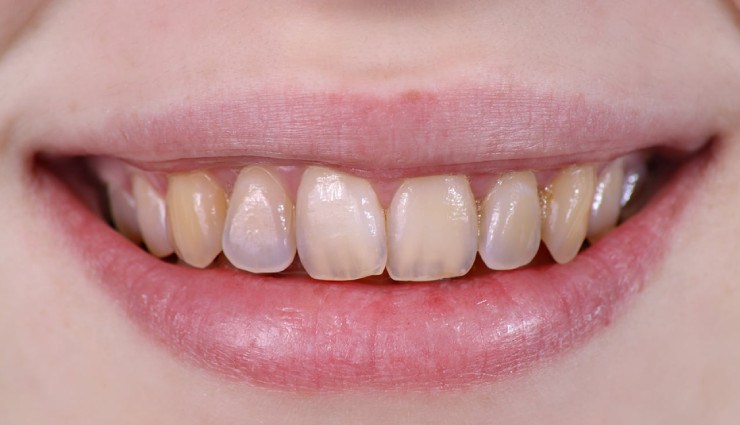Tooth enamel is the hardest substance in your body, even more, complicated than your bones. This material covers the outer layer of the tooth and protects the crown and the innermost layers of the tooth (dentin and pulp) against damage, decay, and daily erosion. Although the enamel covering the teeth is strong, bacteria, plaque, and acids in the mouth can damage it, and if you do not maintain good oral hygiene, it may be lost. Therefore, we suggest you stay with us until the end of the article to protect your teeth.
What is tooth enamel?
Tooth enamel is the outer protective layer of the tooth. This layer protects the crown part (the tooth’s visible part above the gum). Enamel is the hardest substance in the body, even more, complicated than your bones, yet it can also become damaged over time.
The structure of tooth enamel
Tooth enamel contains more calcium and phosphorus. These minerals comprise over 95% of enamel and form a hydroxyapatite solid crystalline structure. The rest of the enamel structure consists of water (4%) and protein (1%).
Other constituent minerals are:
- carbonate;
- Fluoride;
- magnesium ;
- sodium
Enamel is a semi-transparent structure. Tooth dentin (the bottom layer) may have different colors, from whitish to bright yellow. Together, enamel and dentin create the final color of the tooth.
The cause of tooth enamel loss
Enamel decay occurs when acids erode the hard outer layer of the tooth. Saliva neutralizes the acids in the mouth, but specific diets, poor oral hygiene, and medications like aspirin can make it harder for saliva to do the job. Sweet foods, foods containing starch, and acidic foods and drinks such as fruit juices or carbonated beverages are the main culprits of acid production.
Other factors also contribute to the loss of tooth enamel, including:
- Environmental factors such as friction and daily erosion;
- Grinding teeth or clenching teeth;
- Consuming acidic foods such as sour candies;
- dry mouth ;
- gastroesophageal reflux disease or similar digestive disorders;
- bulimia nervosa (induced vomiting can erode tooth enamel);
- Genetics. (Some people have thinner enamel.)
Since enamel plays a vital role in protecting the inner parts of the teeth, its erosion can cause tooth decay, infection, and sensitivity, make the teeth sensitive to temperature and taste or cause them to scratch or crack.
Complications of tooth enamel damage
Enamel protects the surface of the tooth and its inner parts, such as dentin and dental pulp, against various damages. Enamel damage has complications, including:
- Tooth decay: Enamel layers may wear down, and this can cause tooth decay. The symptoms of tooth decay are more sensitivity, pain, and bad breath. Methods such as filling, root canal treatment, and tooth extraction can be used to treat caries.
- Cracked tooth: When the enamel wears away, small cracks may appear in the tooth. Also, if a part of the tooth enamel is lost, you may have a scratched or chipped tooth. A cracked or chipped tooth may require bonding with special adhesives or root canal treatment.
- Tooth color change: Enamel is essential for tooth color. Improper care and aging mean that the enamel does not retain its white or off-white color and turns yellow, dark brown, or black. Tooth discoloration may be corrected with home remedies.
Erosion, infection, and tooth sensitivity to heat, cold, and sweets are other complications of tooth enamel damage.
Tooth enamel protection

Prevention is the best way to maintain health and strengthen tooth enamel. There are various tips to maintain oral hygiene, some of which we have reviewed below.
1. Brush your teeth at least twice a day
Doing this removes plaque, sediment, and bacteria from the tooth’s surface and reduces the possibility of damage. If you are unsure how to brush your teeth, talk to your doctor.
2. Floss once a day
Plaque food particles and bacteria hide in the corners, especially between teeth. Flossing is as important as brushing.
3. Use fluoride toothpaste
Different types of toothpaste are available in stores. Choose toothpaste that contains fluoride. Daily consumption of fluoride helps to strengthen and mineralize enamel. Also, pay attention to the standard mark on the toothpaste. This mark determines the safety and effectiveness of the toothpaste.
4. Use a toothbrush with a soft brush
Do not use toothbrushes with regular or stiff bristles. These toothbrushes can scratch the enamel on your teeth. Also, brush your teeth gently.
5. Drink acidic drinks with a straw
Drinking acidic beverages such as carbonated soft drinks with a straw reduces the contact of these liquids with tooth enamel. Also, avoid acidic foods as much as possible. Many foods such as vegetables, fruits, milk, and foods containing fluoride, green tea, and spinach are good for teeth.
6. drink water
Drinking daily water helps remove plaque, bacteria, and food debris. Also, drinking water reduces the possibility of losing tooth enamel in people with dry mouths.
7. Use supplements
Use supplements if you are not getting enough vitamins and calcium through your diet.
8. Treat underlying diseases
Some of these diseases are dry mouth, return of stomach acid to the esophagus, and bulimia nervosa, which can be treated to prevent tooth enamel damage.
9. If you grind your teeth, use a toothpaste
You can get the guard from a pharmacy, or your doctor can make your guard.
10. Use sugar-free gums
These gums increase saliva production and help maintain tooth enamel health. Use gum containing xylitol. This natural sugar alcohol can help prevent tooth decay.
11. Ask your doctor about dental fillings
Dental sealants are thin plastic-like coverings placed over your teeth and act like a little raincoat to protect your teeth from plaque, food particles, and harmful bacteria.
12. Visit the dentist regularly
Regular periodical examinations are necessary to maintain the health of teeth and gums.
Dealing with injuries

Erosion of tooth enamel causes the tooth’s inner layers to be exposed to air, food, and drinks. As a result, your tooth will be more susceptible to decay. Also, the enamel loss makes your teeth more sensitive to heat, cold, and sweets. These structures may also stain more easily.
Fortunately, early tooth decay is reversible, and dentin can repair minor cavities. Of course, even small holes, if left untreated, may develop into larger holes to the point of causing infection and painful tooth abscesses.
Common questions
1. Can tooth enamel be regenerated?
If the enamel is completely gone, it will not grow back, and you cannot rebuild it naturally or artificially. Of course, you can help mine its remaining parts. Enamel erosion is inevitable in aging, but your dentist can place a dental crown on your tooth and prevent further damage. Also, if the tooth dies, you can use an implant.
2. Is tooth enamel restoration possible?
Yes. Although your body cannot make new enamel, using some substances such as calcium, phosphorus, and fluoride can partially restore and strengthen the remaining tooth enamel. Also, the doctor can repair the damaged enamel with fluoride therapy. Fluoride remineralizes and supports the outer layer of the tooth.
3. What is fluoride?
Fluoride is a natural substance found in water and many foods. This substance is available in tablets and topical fluoride (placed on the teeth by the doctor). The doctor uses fluoride for the natural restoration of the tooth so that the tooth becomes less susceptible to decay and other damage.
4. Does teeth whitening damage the enamel?
If this is done correctly, it will not damage the enamel. However, some whitening products can cause enamel dehydration. Talk to your doctor about safe products to whiten your teeth.
5. How to remove dental cracks?
The doctor will fix the cracks or scratches in the tooth with different methods, including:
- use of a crown or cover;
- filling teeth;
- Dental bonding (use of a tooth-colored resin material to repair cracks, lip filling, or short and long teeth);
- Using sealant or glue for filled teeth;
- root canal;
- Tooth extraction and implants.
Trials do not go away with home treatment; you should see a doctor. To maintain the remaining enamel, adopt proper food and hygiene habits.
you say
How do you protect your teeth? Have you ever had tooth enamel decay? You can write us your experience and opinion in the comments section and share this article with your friends through social networks.
Warning! This article is only for educational purposes; to use it, it is necessary to consult a doctor or specialist.



